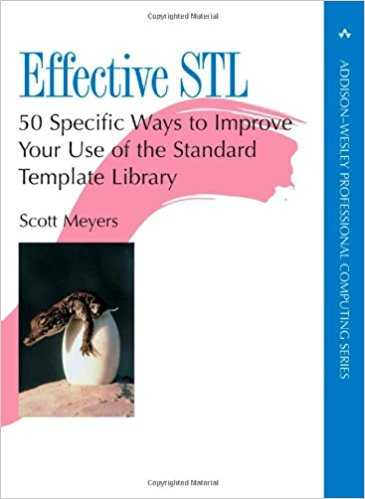标签:led reverse cpp targe for_each rest creat tween consul

Scott Meyers is one of the world‘s foremost authorities on C++, providing training and consulting services to clients worldwide. He is the author of the best-selling Effective C++ series of books (Effective C++, More Effective C++, and Effective STL) and of the innovative Effective C++ CD. He is consulting editor for Addison Wesley‘s Effective Software Development Series and serves on the Advisory Board for The C++ Source (http://www.artima.com/cppsource). He holds a Ph.D. in Computer Science from Brown University. His web site is http://www.aristeia.com.
Item 1: Choose your containers with care. 11
Item 2: Beware the illusion of container-independent code. 15
Item 3: Make copying cheap and correct for objects in containers. 20
Item 4: Call empty instead of checking size() against zero. 23
Item 5: Prefer range member functions to their single-element counterparts. 24
Item 6: Be alert for C++’s most vexing parse. 33
Item 7: When using containers of newed pointers, remember to delete the pointers before the container is destroyed. 36
Item 8: Never create containers of auto_ptrs. 40
Item 9: Choose carefully among erasing options. 43
Item 10: Be aware of allocator conventions and restrictions. 48
Item 11: Understand the legitimate uses of custom allocators. 54
Item 12: Have realistic expectations about the thread safety of STL containers. 58
Item 13: Prefer vector and string to dynamically allocated arrays. 63
Item 14: Use reserve to avoid unnecessary reallocations. 66
Item 15: Be aware of variations in string implementations. 68
Item 16: Know how to pass vector and string data to legacy APIs. 74
Item 17: Use “the swap trick” to trim excess capacity. 77
Item 18: Avoid using vector<bool>. 79
Item 19: Understand the difference between equality and equivalence. 83
Item 20: Specify comparison types for associative containers of pointers. 88
Item 21: Always have comparison functions return false for equal values. 92
Item 22: Avoid in-place key modification in set and multiset. 95
Item 23: Consider replacing associative containers with sorted vectors. 100
Item 24: Choose carefully between map::operator[] and map::insert when efficiency is important. 106
Item 25: Familiarize yourself with the nonstandard hashed containers. 111
Item 26: Prefer iterator to const_iterator, reverse_iterator, and const_reverse_iterator. 116
Item 27: Use distance and advance to convert const_iterators to iterators. 120
Item 28: Understand how to use a reverse_iterator’s base iterator. 123
Item 29: Consider istreambuf_iterators for character by character input. 126
Item 30: Make sure destination ranges are big enough. 129
Item 31: Know your sorting options. 133
Item 32: Follow remove-like algorithms by erase if you really want to remove something. 139
Item 33: Be wary of remove-like algorithms on containers of pointers. 143
Item 34: Note which algorithms expect sorted ranges. 146
Item 35: Implement simple case-insensitive string comparisons via mismatch or lexicographical_compare. 150
Item 36: Understand the proper implementation of copy_if. 154
Item 37: Use accumulate or for_each to summarize ranges. 156
Item 38: Design functor classes for pass-by-value. 162
Item 39: Make predicates pure functions. 166
Item 40: Make functor classes adaptable. 169
Item 41: Understand the reasons for ptr_fun, mem_fun, and mem_fun_ref. 173
Item 42: Make sure less<T> means operator<. 177
Item 43: Prefer algorithm calls to hand-written loops. 181
Item 44: Prefer member functions to algorithms with the same names. 190
Item 45: Distinguish among count, find, binary_search, lower_bound, upper_bound, and equal_range. 192
Item 46: Consider function objects instead of functions as algorithm parameters. 201
Item 47: Avoid producing write-only code. 206
Item 48: Always #include the proper headers. 209
Item 49: Learn to decipher STL-related compiler diagnostics. 210
Item 50: Familiarize yourself with STL-related web sites. 217
C++学习书籍推荐《Effective STL(英文)》下载
标签:led reverse cpp targe for_each rest creat tween consul
原文地址:https://www.cnblogs.com/awesome-share/p/10046739.html